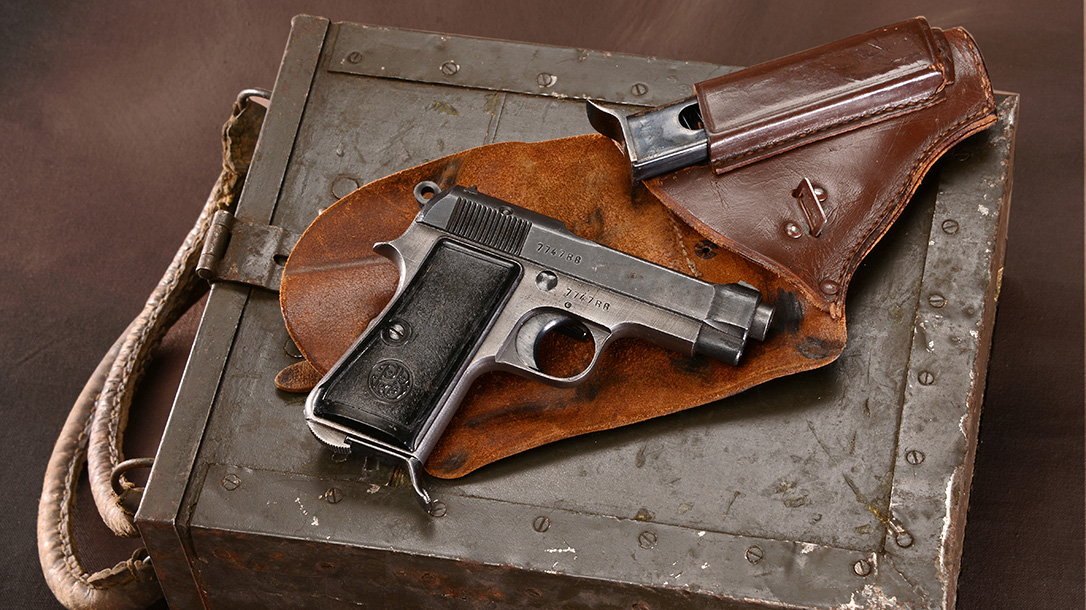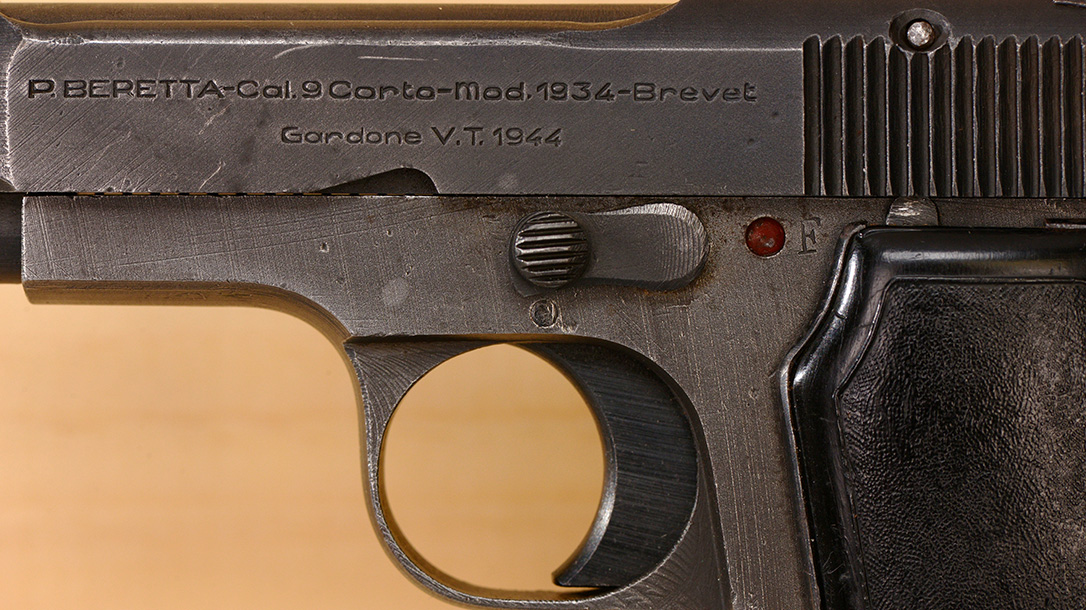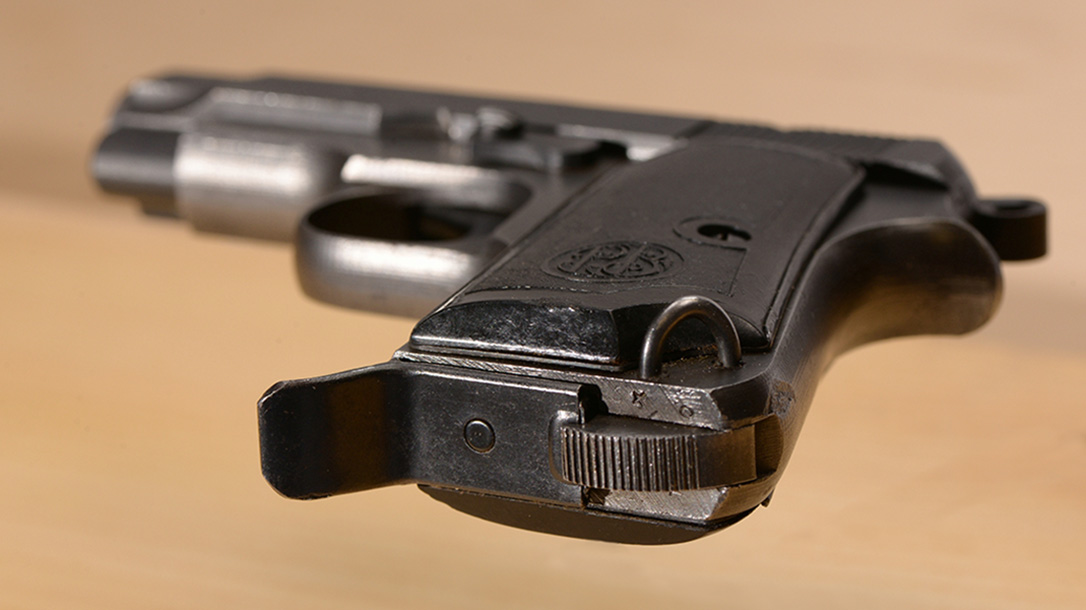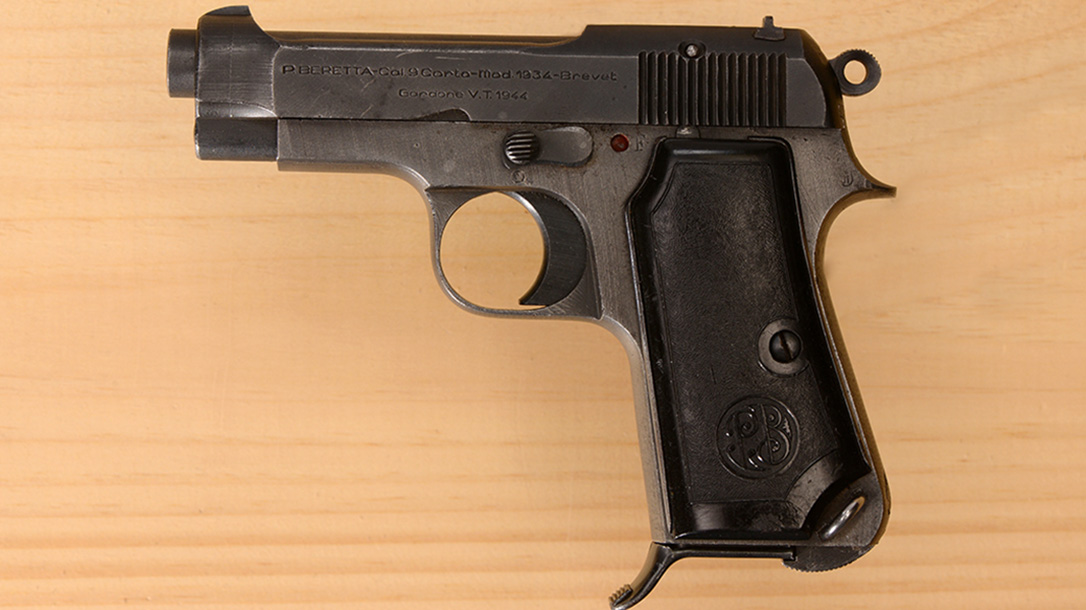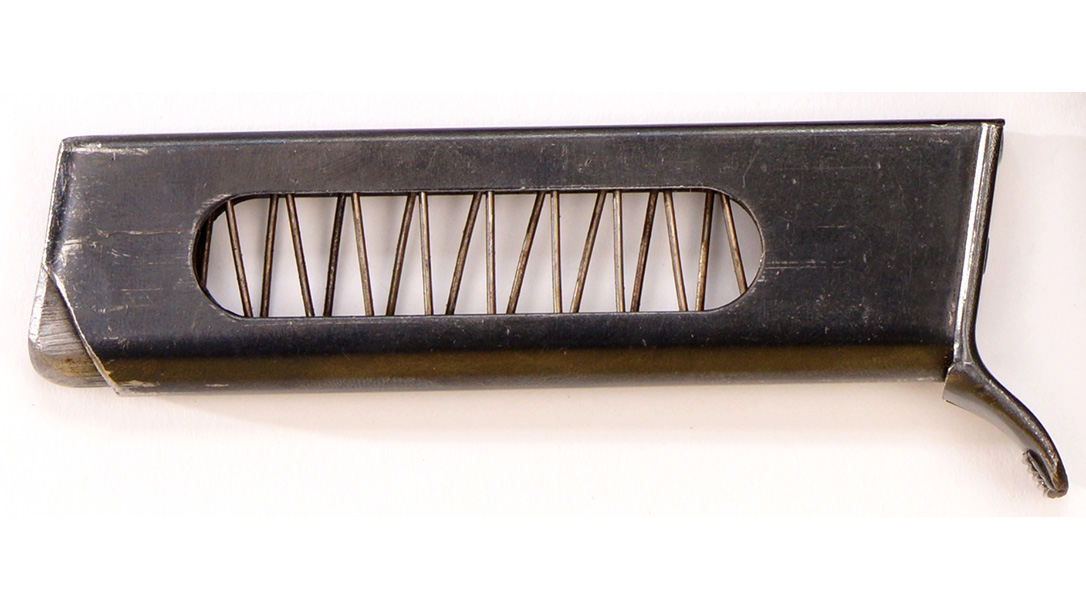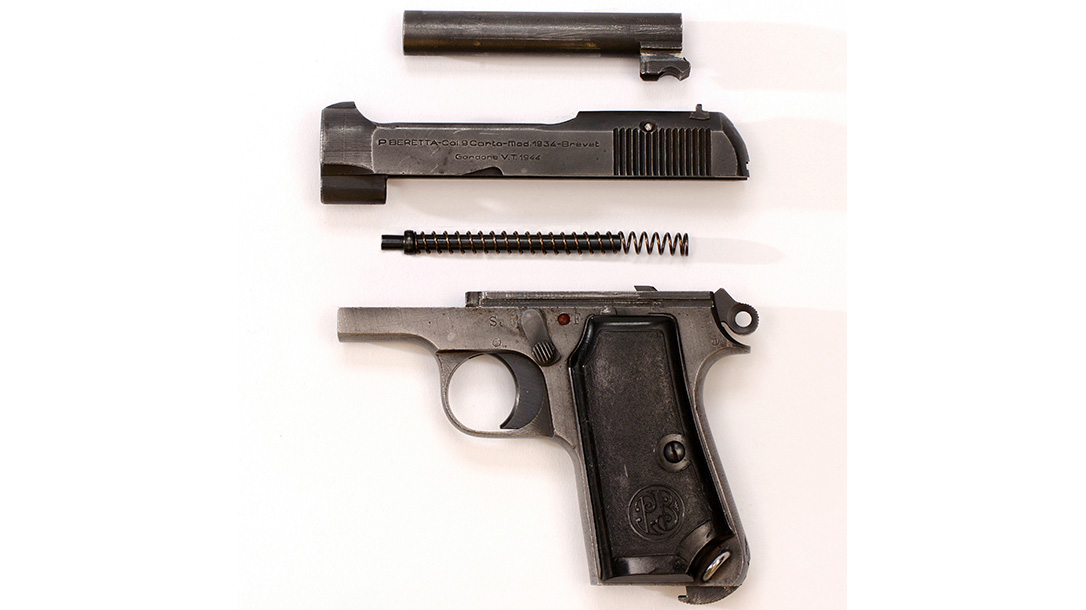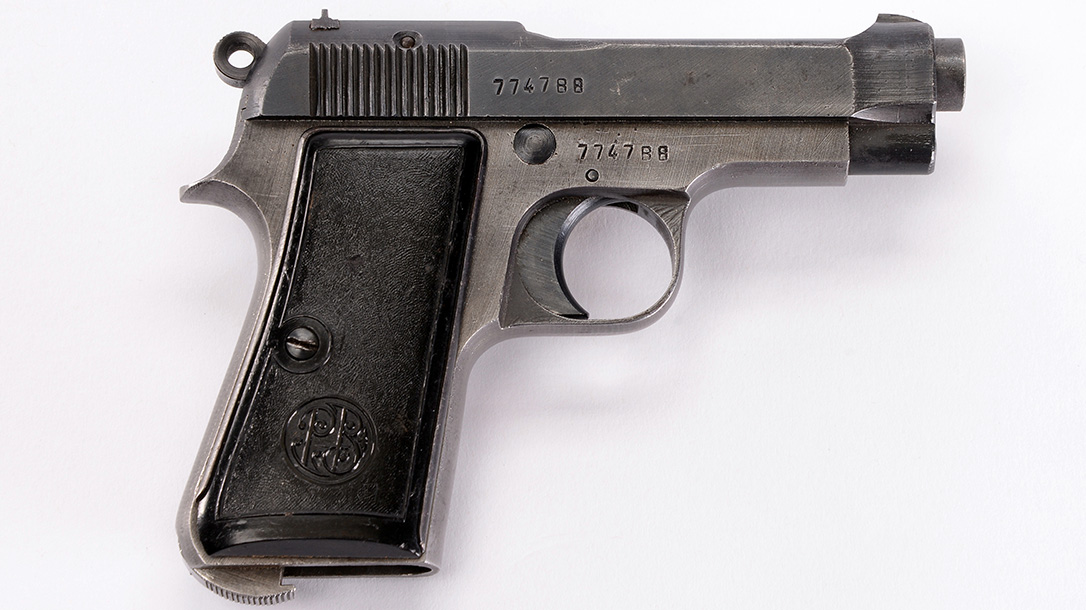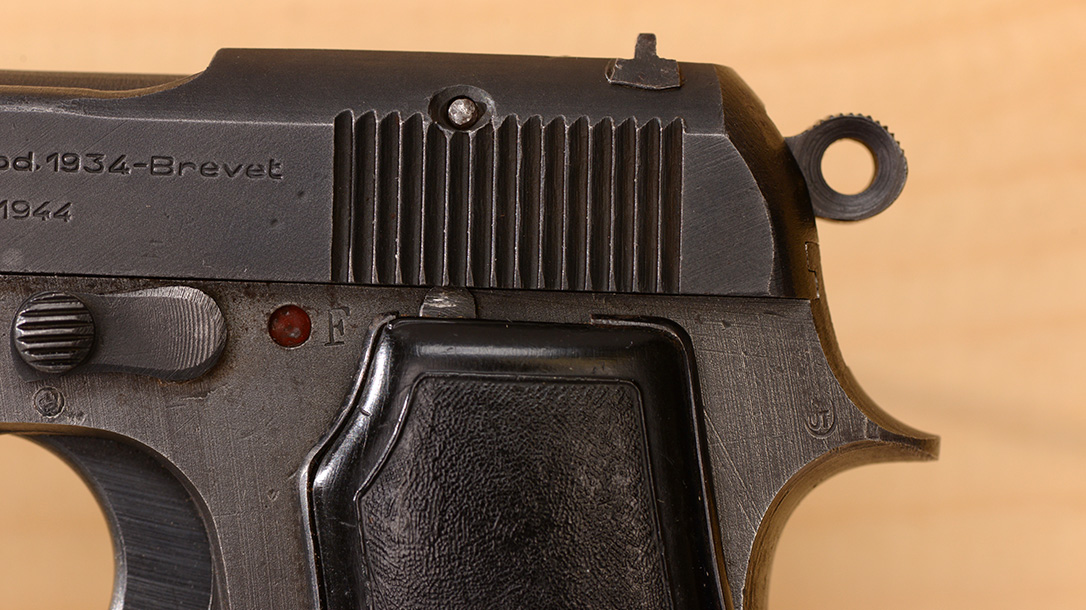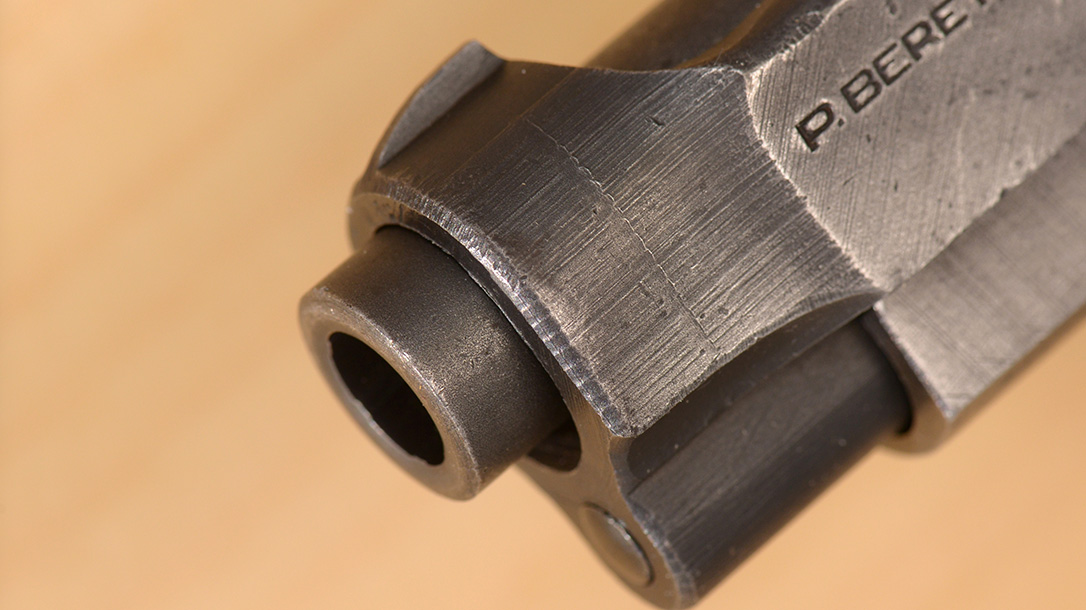Beretta is not only the oldest firearms manufacturing company in the world, but it is also the oldest continuously family-run business in the world. It was established by Bartolomeo Beretta as early as 1526. During World War II, it was the leading producer of submachine guns and pistols for the Italian armed forces.
Beginnings
Of the Beretta pistols, the best known and most familiar to American gun enthusiasts is the Model 1934 in .380 ACP. It was a very popular weapon not only with the Italians but also with German and Allied troops as well, as it was light, handy and functioned well under various climatic conditions. It proved itself in Italian service from North Africa to Russia.
Advertisement — Continue Reading Below
A somewhat apocryphal story regarding the Model 1934 is often told among Italians. As the story goes, during the campaign in Russia, one night an Italian officer whose unit was operating alongside the Germans went to sleep after having removed his holstered Model 1934 and put it by his side. When he awoke in the morning, his Beretta was gone, replaced by a holstered Luger left there in exchange by some unnamed German who had crept in during the night to make the swap. Whether true or not, it does underscore the reputation that the pistol had for reliability under adverse conditions. The Model 1934 was a very desirable war trophy for American GIs serving in Italy, and as a result, the pistol is readily available on the collector’s market in the U.S.
Sidearm Search
The Model 1934 traces its development back to the Beretta Model 1915. It was designed by Tullio Marengoni, Beretta’s most prolific and well-known gun designer. In the early 1930s, it became obvious to Italian authorities that pistols like the Model 1889, the Glisenti and some of the early Berettas then issued to the armed forces and police agencies were not up to contemporary standards and were no longer adequate for military requirements.
It required no extraordinary effort for Marengoni to take the design a step further than the Model 1931, chambered for the 7.65mm Browning (.32 ACP), by adopting the 9x17mm (.380 ACP) round, known and referred to in Italy as the 9mm corto, or 9mm Short. This resulted in the Model 1932. Save for its grip panels and slide markings, it was identical to the Model 1934. The 9mm corto, also known in Italy as the “9M34” and driving a 93-grain bullet at 985 fps, was chosen by the Italians in order to ease logistic problems by adopting a standard pistol cartridge for their armed forces.
Advertisement — Continue Reading Below
Although adopting yet another cartridge type to alleviate the problem was an apparent anachronism, the wisdom of adopting the 9mm corto was vindicated during the war. The Beretta Model 1934 was the most widely produced and issued Italian pistol of WWII. All things considered, given the evolutionary path of the Beretta semi-auto pistols, adoption of the 9mm corto round was a reasonable choice at the time and under the circumstances. It should be noted parenthetically that Beretta later introduced the Model 1935. This pistol was almost identical to the Model 1934. However, it was chambered for the 7.65mm Browning (.32 ACP) cartridge.
Simple But Effective
The Model 1934 is a simple blowback-operated weapon. Its return spring and guide are located below the barrel; the barrel itself remains stationary during firing. However, it can be easily removed for maintenance. It has the characteristic Beretta open-top slide design introduced by Marengoni on the Model 1917 pistol. The safety is on the left side of the frame above the trigger. It must also be rotated a full 180 degrees to the “safe” position or to disengage the safety to the “fire” position; the same lever acts as the slide lock to disassemble the pistol. There is no dedicated slide stop mechanism; the slide is held open after the last round is fired by the magazine follower.
Notable features introduced on the Model 1934 were the half-cock safety position for the exposed hammer. In addition, it had steel-backed Bakelite grips (known as filbak in Italian). The pistol lacked features such as a magazine disconnect and a loaded-chamber indicator found on contemporary German pistols. But the simple design and few working parts eliminated the need for many complicated milling operations. This enabled it to be easily mass-produced. In addition, the Model 1934 is rugged and well built, easy to maintain and very reliable. These positive attributes are offset to some extent by the fact that the 9mm corto cartridge is considered somewhat underpowered for a military pistol.
Advertisement — Continue Reading Below
The Finish
Adhering to Beretta’s reputation for superior craftsmanship, up until the latter stages of World War II, the pistols were well finished and nicely blued. However, as the war progressed and the requirement for weapons took on added urgency, increasingly less time was devoted to the exterior finish, so it is common to encounter late-war examples with very rough exterior finishes exhibiting sharp edges and conspicuous machine marks.
By late 1944 or early 1945, the blued finish was phased out in favor of a phosphate finish. This eliminated the need for time-consuming polishing operations. However, despite the shortcuts taken with respect to the exterior finish, Beretta maintained tight tolerances for the mechanical components and continued to use high-quality materials. Therefore, nothing was compromised the pistols’ reliability. The only other manufacturing shortcut worthy of note regarded the magazine rather than the pistol itself. Early magazine floorplates were milled while later floorplates were made of stamped sheet metal.
Arming Italy
The first contract for the Model 1934 pistol was signed in 1935. The contract was for 1,000 pistols to be issued to the Pubblica Sicurezza police force. In March of 1936, an order for 250 Model 1934 pistols was also placed by the Milizia Portuaria (Port Militia). This was followed in June of 1936 by the first sizeable Italian army contract for 150,000 Model 1934 pistols. However, the Model 1934 was not officially adopted in service until October 16, 1936.
Advertisement — Continue Reading Below
The reason for this delay was that the Italian army requested that Beretta add a Walther-type safety on the slide that blocked the firing pin. Although some Model 1934s incorporating the firing pin safety were produced, when Beretta informed the government of the additional cost per pistol that would be incurred, the original design was accepted.
Between 1938 and 1940, the Italian army placed two more orders, one for 80,000 and another for 165,000 pistols. Subsequent orders equipped all three military services. Monthly production figures varied considerably. During the second half of 1942, production ran between 3,000 to 10,000 Model 34 pistols per month; a figure of 23,000 was achieved in March of 1943. Each pistol was issued with a leather holster and two magazines. Officers were issued a brown holster; NCOs and other ranks were issued a grey-green holster. In addition, Carabinieri personnel were issued a black holster.
German Control
After Italy signed an armistice with the Allies in September of 1943, the Beretta plant, which was located in northern Italy under German control, also continued to make the Model 1934 for use by German forces. One source cites a figure of 53,725 Model 1934 pistols produced under German control. In December of 1943, however, the Germans decided to cease production of the Model 1934. Instead, all of their resources were devoted to production of the 7.65mm Model 1935 pistol. This allowed only continued assembly of the Model 1934 with parts that were already on hand.
Advertisement — Continue Reading Below
An estimated 18,000 to 19,000 Model 1934 pistols in the “AA” and “BB” blocks were produced between 1944 and 1945. Many of the pistols produced under German control bore the marking “4UT” (for 4 Ufficio Tecnico di Controllo Armi e Munizioni, or the 4th Technical Office for Arms and Munitions Inspection), which was responsible for acceptance of many, but apparently not all, Italian weapons from 1941 through the period of the Italian Social Republic, or RSI. This mark was also usually on the right tang.
Contrary to popular belief, the 4UT, also at times noted as “IV U,” was not a German-run agency or the Italian equivalent of the Waffenamt. A number of the pistols, however, did also bear the German Waffenamt “WaA 162” signature, some with and some without a circled swastika. The German designation for the Model 1934 was “P671(i),” but it was never applied on the Model 1934 pistols produced under German supervision. Use of the Fascist-era date in Roman numerals was also discontinued after July of 1943.
Going Abroad
The Model 1934 enjoyed modest export success. In 1940, Romania placed an order for 61,000 of the pistols, but ultimately only 37,000 to 40,000 were delivered. The only differences between the standard Italian pistol and the Romanian version were that the caliber marking on the slide appears as “9 Scurt” (9mm Short) in Romanian, and the Fascist date in Roman numerals is omitted.
Advertisement — Continue Reading Below
Another fairly small order for the Model 1934 was made by Finland. In July of 1941, the Finns ordered 500 Model 1934 pistols that were not delivered until April 1943; all apparently were issued to the Civil Guard (Suojeluskuntain Yliesikunta). These pistols, marked “Sk.Y” with serial numbers ranging from 0100 to 0597, are quite rare. An additional order for the Model 1934 was also placed, possibly for 1,000 examples, for use by the Finnish army, and were marked “SA” (Suomen Armeija). There are also other estimates as to how many Model 1934 were sold to Finland, ranging from a low of 900 to a high of 1,400.
There are vague and unsubstantiated references to Model 1934 pistols having been provided to Bulgaria and Poland, as well as the suggestion that there were two lots of Model 1934 and Model 1935 pistols sold to Japan. The first lot supposedly was sent out aboard either Italian or Japanese submarines in 1941 or 1942, and a second lot of about 9,000 later in the war may never have even made it to the port of embarkation in France.
GECO Pistols
In addition to military export sales, the Model 1934 was exported to Germany commercially. In Germany, it was marketed by the firm of Gustav Genschow, whose trademark was “GECO.” The left-hand side of the slides on GECO pistols lacked the standard Beretta markings, which instead appeared in an abbreviated format on the frame itself; the serial number appeared in the normal location on the right-hand side of the slide and frame. The left tang carried civilian proof marks as well as the year below the proof marks, and the right tang was marked with a stylized GECO logo.
Advertisement — Continue Reading Below
Making A Mark
Although basic markings on the Model 1934 are somewhat consistent, there are many variations and nuances that can be encountered. For pistols in Italian service, markings on the left side of the frame above the grip tang indicate the arm of service. Army-issued pistols were marked with the letters “RE” for Regio Esercito (Royal Army); Navy pistols bore the letters “RM” for Regia Marina (Royal Navy) within a circle, also with an anchor between the letters “R” and “M,” or a shield divided into four quadrants, and air-force-issued pistols also bore the letters “RA” for Regia Aeronautica (Royal Air Force) with an eagle mounted on a royal crown. The marking for the Milizia Forestale (Forestry Militia), and later the Guardia Forestale (Forestry Guards) had an eagle and crown and two crossed axes.
The serial number was on the right side of the slide and frame as well as on the barrel. The left side of the frame also bore the maker’s name, caliber, model number (1934) and the Italian word Brevettato (patented), or its abbreviated form—Brevet—on one line, and a second line reflecting the place of manufacture (Gardone V.T.) and the year of manufacture. In addition to being marked with the year of production in Arabic numerals, the year of production is also shown in Roman numerals according to the Fascist calendar in which 1923 was year I.
It is problematic as to whether or not any pistols in the “AA” suffix range bearing the eagle and crown were ever in fact issued to the air force of the Italian Social Republic. Guns in the “BB” suffix range, produced from August 1944 to January 1945, were finished only in a very summary fashion on the exterior, in the so-called “wartime finish.”
Advertisement — Continue Reading Below
Additional Details
There were two periods when the Model 1934 was produced with a blank slide. From July 25, 1943, when Mussolini was deposed, until September 8, 1943, when Italy signed an armistice with the Allies, Beretta was unsure of precisely what markings (especially the Fascist year markings) should be applied. Later, as the war was drawing to a close, sometimes only the caliber and serial number appeared on the frame.
The serial number range for early Model 1934 pistols was a continuation of the “500000” block that had begun with the Model 1932. When serial number 999999 was reached, rather than continuing on with a seven-digit serial number, Beretta began numbering its Model 1934s with an “F” prefix; there seems to be no explanation as to why the initial letter prefix was an “F” rather than an “A.”
The “F” and “G” blocks were followed by “AA” and “BB” suffix blocks. The “C” block began in 1946, and post-war blocks continued through the alphabet until the “H” block. The last Model 1934 pistols, issued to the Guardia di Finanza in 1980, bore a “T” prefix. A total of 1.08 million Model 1934 pistols were produced all together.
Beretta Model 1934 Specs
| Caliber: .380 ACP |
| Barrel: 3.4 inches |
| OA Length: 6 inches |
| Weight: 23.28 ounces (empty) |
| Grips: Bakelite |
| Sights: Blade front, notch rear |
| Action: SA |
| Finish: Blued or phosphated |
| Capacity: 7+1 |
Editor’s Note: The author wishes to thank Gianluigi Usai for his advice and assistance in preparing this article.
